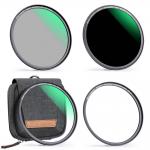
67mm MCUV+CPL+ND1000+Adapter Ring Magnetic 4 in 1 Lens Filter Kit Waterproof Scratch-Resistant Anti-Reflection with Filter Pouch
SKU: SKU.1624
K&F Concept’s Magnetic Lens Filter Kit, which includes a UV filter, a circular polarizer, and a neutral density filter, along with an adapter ring, is a good concept that isn’t quite executed correctly.The idea behind a magnetic lens filter kit is a good one, as it’s never fun to fumble around changing filters when you are trying to get a photo, especially if you are hiking and not in a position to lay down the camera on a clean surface and carefully remove and replace filters.I tested this kit with the Nikkor Z 24mm-200mm lens, which takes 67mm filters, and removed the existing UV filter I had on the camera. The adapter screws on fine, but now with the K&F Concept adapter on the lens, the lens cap falls off easily. The situation improved slightly with the addition of the K&F circular polarizer on the adapter, but the cap still did not stay in place.I even tried keeping my original UV filter on the lens, along with the adapter and then the circular polarizer, and the situation did improve a bit, but I don’t like having a double layer of glass in front of the lens element. I also tried the adapter with an F mount lens with a 67mm diameter, and the result was a little better as F mount lenses have different lens caps.The filters themselves work well and seem to be of good quality. Included with this review is a photo taken with the circular polarizer. The filters themselves are very thin, which is perhaps why the lens cap does not stay on, and the movement of the circular polarizer is smooth. The filters come with a nice carrying case as well.Bottom line, I like the concept of magnetic filters, but, at least with the Z mount 24mm-200mm lens, the adapter and filters are too shallow for the lens cap.
01/01/1970
My circular filter kit for each lens size includes a protective UV, a CPL and ND 10 and 6 stop. The K&F kits contain all but the 6 stop. The 6 stop can be ordered separately, though at this time only from the manufacturer's website.For any given size kit, the K&F Concept magnetic kit costs far far less than would top line individual threaded filters from other manufacturers (Breakthrough Photography, B+W, Hoya HD3, etc.). Yet the optical qualities of these K&F have been tested and are equal to the best. My own experience is that the K&F coatings are also just as effective at repelling water droplets as are my most expensive filters.Having used K&F Concept magnetic filters in two sizes for a few months I am loving the speed of filter changes and the absence of thread jamming when I stack an ND on a CPL.My only criticism is the lack of knurling on the front edge of the CPL frame. Magnetic CPL filters do not need or have a two piece construction. The entire filter is rotated in its magnetic attachment, which is fine but remains a two-finger grasping maneuver. To rotate the CPL you'll need to temporarily remove the lens hood. Maybe had K&F added knurling to the from edge a fingertip would suffice, but there is more friction opposing rotation than in a well made two piece threaded CPL. Off course you could attached your old threaded CPL to the lens, screw the open ring magnetic adapter onto the CPL, then add your NDs magnetically. You'd risk jamming the adapter ring to the front threads of your old CPL. I'm not going to do this.The protective UV is only meant to be attached directly to the lens threads. It is a lens protector. It does not magnetically attach atop the other filters or the open adapter ring. You are give two threaded adapters, one is just an open magnetized frame. The other has the protective glass. The CPL or ND can be clicked onto this protective filter, but not the other way around. My advice is to use the protective UV when facing blowing sand or salt laden ocean mist (and when shooting from a Russian reindeer sleigh where showered by flying feces).The included pouch is well made and easy to use. If you buy kits in multiple sizes you can even combine them into one pouch by storing the filters magnetically stacked and assigning each compartment of one pouch to a different diameter.
01/01/1970
